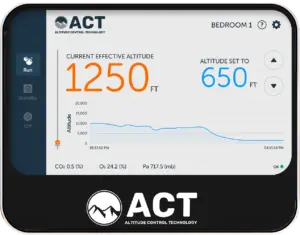ACT CONTROLLER TECHNOLOGY
ACT’s controller was developed in conjunction with the U.S. Government and made specifically for altitude simulation. It is the result of more than $3 million in research and development. Hardware and software work together to form an integrated and comprehensive system for accuracy, stability, and reliability.
ACT’s controller continuously monitors all sensor inputs and controls oxygen and ventilation to assure accurate altitude simulation and high air quality. It provides both real-time and historical data. Twenty-one independently programmed drivers can control vents, dampers, mode selectors, and other equipment to control altitude simulation, air exchange, and other environmental factors.
Smart systems automatically manage oxygen levels, energy consumption, sensor accuracy, and air separation modes. The control system is virtually maintenance-free over its entire life. ACT’s control system is state of the art with features found in no other system.
ALTITUDE SIMULATION ALGORITHMS
The ACT controller incorporates seven important algorithms:
Partial Pressure Calculation ACT’s proprietary algorithm incorporates real-time barometric pressure and oxygen concentration readings to calculate the partial pressure of oxygen – true altitude. ACT’s unique system adjusts oxygen levels according to barometric pressure to simulate the desired altitude. Without this algorithm, a system can only control oxygen levels – an inaccurate means of approximating altitude.
West Equations The West Equations are the gold standard of the science of altitude simulation. They have been empirically validated in studies and represent the most advanced and accurate means to convert the partial pressure of oxygen to true altitude simulation.
Atmospheric Tables Atmospheric Tables, although not as accurate at the West Equations, may be selected.
Oxygen Levels This mode stabilizes an oxygen percentage only.
Fire Safety In oxygenation applications, this algorithm uses pressure sensor readings to calculate the maximum safe oxygen level to meet National Fire Protection Association (NFPA) standards.
Air Quality This algorithm takes readings from the CO2 sensor and can manage ventilation to meet OSHA standards for air quality and eliminate extraneous variables.
Oxygen Control This algorithm calculates the proper response to current atmospheric, oxygen, and air quality conditions and then triggers the correct mix of responses from each of ACT’s air units to precisely titrate oxygen levels.
Energy Savings Using data from ACT’s occupancy detection technology, this algorithm minimizes energy consumption when rooms are unoccupied.
These algorithms provide a completely automatic system by working in conjunction with ACT’s sensors and air separation units to ensure accurate altitude simulation, fire safety, and high air quality at all times.
ACT ALTISTAT™ TOUCHSCREEN

ACT’s Altistat™ touch screen user interface is simple and intuitive. Most people can operate it with no training at all. Users select altitude settings with the easy-to-use in-room touchscreen or any device with an Internet connection. ACT’s quiet and unobtrusive system prepares the room for a user’s arrival, and maintains safe and effective oxygen levels regardless of activity within the room.
Multiple screens include:
Night Time Screen for minimum light to facilitate sleeping
Altitude Display Screen for a clean and simple display
Full Display Screen to display all data, including real-time graphs
Settings Screen full access for authorized personnel
Other features include:
1. Automatic scheduling of the system (mobile app)
2. Altitude readings in feet or meters
3. The ability for remote sensors
4. Full-color screen
5. Custom graphics selected by the customer that can include a logo
DATA LOGGING
ACT’s controller automatically logs data to the cloud. Sampling occurs every six seconds, keeps records automatically and ensures the health of the system. Logs include:
1. Altitude Simulation
2. Barometric Pressure
3. Oxygen Percentage
4. CO2
5. Partial Pressure of Oxygen
6. Temperature
7. Humidity